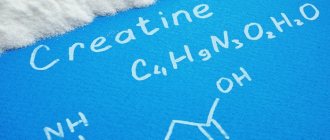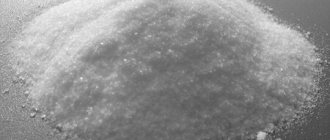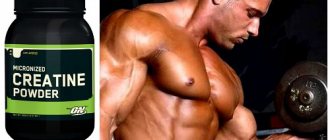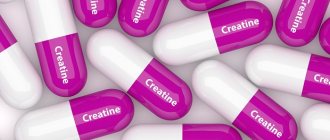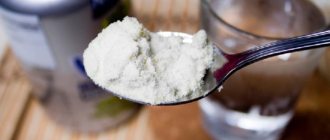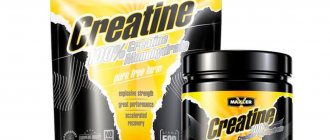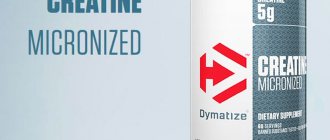© designer491 — depositphotos.com
Share:
Creatine (aminocaboxylic acid) is a source of energy and a compound that has a beneficial effect on the quality of muscles, increasing their strength and endurance. It is believed that the body contains an average of 100-140 g of the substance, 95% of which is contained in the muscles in a free state and in the form of phosphate.
It is synthesized with the participation of glycine, arginine and methionine, forming an amino acid complex. Approximately 2 g are consumed per day with food, mainly with fish and meat. For athletes involved in strength sports (bodybuilding, crossfit and others), this is not enough. Additional dosages in such forms as creatine powder, tablets or capsules increase the effect of training and accelerate the process of weight loss (fat burning).
Content
- 1 Creatine in bodybuilding 1.1 History of creatine
- 3.1 Increased strength
- 5.1 Creatine and children
Top Creatine Phosphate Supplements
Creatine can be found in all brands of sports nutrition:
- Optimum newtrition;
- Ultra;
- Biotech, Dimatize, others
Domestic sports nutrition manufacturers are not lagging behind, and each offers us their own versions of creatine.
Types of additives
Manufacturer brands more or less cope with the task of supplying high-quality creatine. This supplement is difficult to spoil, so it makes sense to consider only the types of creatine
Creatine monohydrate . It loads quickly, as you can consume up to 50 g of creatine per day. It is well absorbed by the body, does not contain any impurities or additives, and is easy to use.
Creatine phosphate . This is a cheaper supplement with lower bioavailability. Therefore, you need to exceed the dosage recommended by the manufacturer by about a quarter so that the body absorbs all the creatine provided.
Creatine with transport system . An option for those who don’t want to waste time searching for sweet juices and drink a lot of tea. It is convenient to stir it and drink it before training to satisfy the body's need for creatine. Usually creatine with transport is the most expensive, so for loading they take regular one, and this one they simply drink before training to reduce the time spent on taking supplements.
Creatine hydrochloride . This is an innovative product designed to provide all the benefits of creatine without flooding your body with water. Designed for those who want to maintain a drier, more toned appearance. In fact, creatine hydrochloride does not have any proven advantages over monohydrate, so you should decide for yourself whether to purchase it or not.
Interesting fact : creatine is often added to industrially produced gainers. There are also special products containing caffeine, carnitine and creatine. They are designed to help those who have problems gaining weight gain muscle mass. Creatine promotes the retention of glycogen and water in the muscles, its use helps to quickly gain weight. But as soon as you stop taking the gainer, the “water” will drain away.
The same goes for pre-workout mixtures with amylopectin, creatine, and caffeine. They allow you to work out your workout more efficiently, work as a mild pre-workout complex, increase energy and concentration, promote fluid retention in the tissues, but after taking them, a “rollback” is inevitable.
All types of creatine have approximately the same effect from a physiological point of view. There is no creatine that will help you gain weight without rebound, or otherwise allow you to maintain results on its own. Judging by the reviews, even innovative forms of creatine still provoke “flooding” of the body with water, which is quite natural.
Creatine in bodybuilding[edit | edit code]
| What is creatine | |
| Creatine is a natural compound produced in the body from three amino acids (arginine, glycine and methionine) and is also found in meat and fish. It can also be taken in larger doses as a supplement. Creatine is sold both as a separate supplement and as an ingredient in complex supplements. | |
| Effect of creatine | |
| In muscle cells, creatine binds with phosphorus to form phosphocreatine (PC). This energy-dense compound supplies muscles with energy during high-intensity activities such as weight lifting or sprinting. Increasing FC levels through supplementation (usually by about 20%) allows the body to maintain maximal load for longer than normal and recover faster between sets, resulting in increased strength and improved ability to perform repeated sets during training. This effect, in turn, can lead to faster gains in strength and lean body mass from workout to workout. Research shows that creatine supplements can improve performance in high-intensity activities (that is, allow you to perform more repetitions or sets), speed up recovery between sets, and increase total and lean body mass. | |
| Do you need creatine? | |
| If you lift weights, do sprints, or play any sport that involves repetitive, high-intensity movements such as snatching, jumping, or throwing (like rugby or soccer), creatine supplements can help you improve performance, strength, and muscle mass. Scientists from the Australian Institute of Sport found that creatine improved sprint times and agility times in football players. However, creatine may not be effective for everyone—several studies have found that there is no benefit to performance when taking creatine. Since creatine does not improve endurance, its use by endurance athletes should only be considered if the need is to increase muscle strength. | |
| Side effects | |
| The main side effect is weight gain, which is partly due to water retention in muscle cells and partly due to increased muscle tissue. While this effect may be beneficial for bodybuilders and people who exercise with weights, in sports where body weight and speed are critical (i.e. running), or in sports with weight classes, it is more likely to be a hindrance. Some people experience fluid retention when taking creatine, especially during the loading phase. Other reported side effects include cramping and abdominal discomfort, which may be related to dehydration rather than creatine supplementation. Because the kidneys have to process more creatine than normal, there is theoretically a risk of long-term kidney damage. While short-term, low-dose creatine supplementation appears to be safe, the effects of long-term creatine supplementation and/or high-dose creatine supplementation as a single supplement or in combination with other supplements remain unknown. |
Creatine
or
2-(methylguanidino)-ethanoic acid
is a nitrogen-containing carboxylic acid that is involved in energy metabolism in muscle and nerve cells. It is the main representative of the group of ergogenic components of sports nutrition. Available in various chemical forms (monohydrate, hydrotartrate, alpha-ketoglutarate, tricreatine malate ). In the world of bodybuilding, creatine is widely used as a sports supplement to increase strength, muscle mass and short-term anaerobic endurance with proven safety.[1]
FAQ.
Review of the Science on Creatine
History of creatine[edit | edit code]
Creatine was discovered in 1832 by the French scientist Chevreul, who discovered a previously unknown component of skeletal muscle, which he later named creatine, from the Greek kreas, which means “meat.”
After Chevreul's discovery of creatine in 1835, another scientist, Lieberg, confirmed that creatine is a common component of mammalian muscle. Around the same time, researchers Heinz and Pettenkofer discovered a substance in urine called “creatinine.” They suggested that creatinine is formed from creatine accumulated in muscles. Already at the beginning of the 20th century, scientists conducted a number of studies of creatine as a dietary supplement. It has been found that not all creatine taken orally is excreted in the urine. This indicated that some of the creatine remained in the body.
Explorers Folin and Denis in 1912 and 1914 Accordingly, they determined that dietary creatine supplementation increased creatine content in muscle cells. In 1923, Hahn and Meyer calculated the total creatine content in the body of a man weighing 70 kg, which turned out to be approximately 110 grams. Already in 1926, it was experimentally proven that the introduction of creatine into the body stimulates the growth of muscle mass, causing nitrogen retention in the body. In 1927, researchers Fiske and Sabbarow discovered “phosphocreatine,” which is a chemically bonded molecule of creatine and phosphate that accumulates in muscle tissue. Free forms of creatine and phosphorylated phosphocreatine are recognized as key metabolic intermediates in skeletal muscle.
The first study to clearly show the effects of creatine in humans was conducted in the late 1980s in the laboratory of Dr. Eric Haltman in Sweden. The study found that consuming 20 grams of creatine monohydrate daily for 4-5 days increased muscle creatine content by approximately 20%. The results of this work, however, were published only in 1992 in the journal Clinical Science, since then the history of taking creatine in bodybuilding begins.
The idea of "loading" and subsequent maintenance dosing was developed by Dr Greenhoff at the University of Nottingham in 1993-1994, the results of which were published jointly with Dr Hultman. Dr. Greenhoff and his colleagues conducted studies in muscle tissue to study the effects of creatine loading.
In 1993, the Scandinavian Journal of Medicine, Science and Sports published a paper showing that creatine supplementation could cause significant increases in body weight and muscle strength (even after just one week of use) and that creatine supplementation was responsible for improved training performance. high intensity.
In 1994, Anthony Almada and his colleagues conducted research at Texas Woman's University. The main purpose of the research was to demonstrate that weight gain with creatine use occurs due to an increase in “lean” muscle mass (without the participation of fat) and that taking creatine leads to an increase in strength indicators (results were tested in the bench press). The research results were published in the journal Acta Physiologica Scandinavica.
Since 1993-1995 Among the new sports nutrition products in bodybuilding, there is no more popular nutritional supplement than creatine. In fact, from that time on, the victorious march of creatine began across countries and continents in a wide variety of sports.
In the early 90s of the last century, low-level creatine supplements were already available in Britain, and only after 1993 a high-quality creatinine supplement was developed to increase strength, available to the mass consumer. It was released by the company Experimental and Applied Sciences (EAS) introducing creatine under the trade name Phosphagen.
In 1998, MuscleTech Research and Development launched Cell-Tech, the first supplement to combine creatine, carbohydrates and alpha lipoic acid. Alpha lipoic acid further increased muscle phosphocreatine levels and total creatine concentrations. Research in 2003 confirmed the effectiveness of this combination, but it must be admitted that the level of effectiveness is quite low.
But Sci Fit scientists went further and developed a new type of creatine treatment in 2001 - Kre-Alkalyn, “cracking the creatine code”, as they wrote about this development in scientific journals in the world of sports and bodybuilding, and patented this invention, receiving patent No. 6,399,611 . Three years later, this news was replaced by a new one, since the disastrous inferiority of this approach was proven.
Another important event occurred in 2004, when the world first heard about Creatine ethyl ester (CEE), which instantly grew in popularity. Currently, CEE is widely used and produced by many companies along with creatine monohydrate. But its effectiveness compared to creatine monohydrate has not been proven.
In addition, in the last decade, tri-creatine malate (Tri-Creatine Malate), dicreatine malate, creatine malate ethyl ester, creatine alpha-ketoglutarate and some other forms of creatine have been synthesized, but they have not gained much popularity due to their low efficiency.
Duration of use
From a theoretical point of view, continuous use of creatine is acceptable because there are no side effects. At the same time, there is a possibility that over time, muscle tissue will become less susceptible to this type of sports nutrition. Therefore, courses lasting 45-60 days are recommended, after which you need to take a break.
But it is worth noting that even with a constant annual intake of creatine, the only thing you will have to face is a decrease in its effectiveness.
Biological role of creatine[edit | edit code]
Creatine is a natural substance found in human and animal muscles and is required for energy metabolism and movement. The human body contains about 100-140 g of this substance, which acts as a source of energy for muscles. The daily consumption of creatine under normal conditions is approximately 2 g. Creatine is as important for life as protein, carbohydrates, fats, vitamins and minerals. Creatine can be synthesized by the body independently from 3 amino acids: glycine, arginine and methionine. These amino acids are components of protein.
In humans, the enzymes involved in creatine synthesis are localized in the liver, pancreas and kidneys. Creatine can be produced in any of these organs, and then transported by the blood to the muscles. Approximately 95% of the total creatine pool is stored in skeletal muscle tissue.
As physical activity increases, creatine consumption also increases, and its supply must be replenished through diet or through the body's own natural production.
The decisive factor for achieving high results in sports is the body's ability to release large amounts of energy in a short period of time. In principle, our body constantly receives energy by breaking down carbohydrates and fat.
The immediate source of energy for skeletal muscle contraction is a molecule called ATP (adenosine triphosphate). The amount of ATP immediately available is limited and is decisive for athletic activity.
All fuel sources—carbohydrates, fats, and protein—are first converted through various chemical reactions into ATP, which then becomes available as the only molecule the body uses for energy. When ATP releases energy to power muscle contractions, the phosphate group is broken off and a new molecule called ADP (adenosine diphosphate) is formed. This reaction is reversed by creatine phosphate, an energy-rich substance.
Creatine combines with phosphate in the body to form phosphocreatine, which is a determinant of energy production in muscle tissue.
Loading
You often see talk on the Internet about “loading” with creatine. Its meaning is that during the first week of the course the athlete takes a double dose of creatine (about 20 g per day), after which he reduces the dosage to normal levels. The essence of this method is to quickly saturate muscle tissue with creatine. This makes sense, but the end result will be the same as without forcing. The only advantage of this “load” is that the results will appear a couple of days earlier, so the relevance of its use remains in question.
Effects of creatine[edit | edit code]
Increased strength[edit | edit code]
In bodybuilding, during high-intensity exercise, the need for ATP in working muscles increases significantly - hundreds of times higher compared to the resting state. Depleted stores of ATP and phosphocreatine must be constantly replenished in order for muscle contractions to continue at peak levels of frequency and force. By increasing phosphocreatine by taking creatine monohydrate, you can increase the amount of ATP and thus increase muscle strength.
Increased muscle mass[edit | edit code]
It is not uncommon to gain dry body mass from 2 to 5 kg in 1 month of use, with systematic training and proper nutrition. Recent experiments prove that creatine monohydrate is able to increase the repeated maximum in the bench press by 10 kg after just a week of use, and improve sprinting abilities. Increasing strength allows you to achieve maximum growth-stimulating effects on muscles. However, it should be noted that taking creatine does not always have a similar effect. It can manifest itself much weaker due to the body’s weak sensitivity to creatine and can be expressed only in a slight increase in performance without an increase in strength qualities.
Muscle quality[edit | edit code]
In addition, creatine also improves muscle definition. Creatine monohydrate binds to water as it is absorbed into muscle cells. As more creatine is stored, more water is drawn into the muscle cell. This explains the hydrating effect of creatine on muscle cells, which are approximately 75 percent water. Bodybuilders notice that a well-hydrated muscle appears fuller, more rounded, and more toned in appearance.
Scientific research shows that when muscle cells increase volume through overhydration, protein synthesis is increased and protein breakdown is minimized (this may also increase glycogen synthesis). This concept was first developed by EAS researchers Anthony Almada and Ed Byrd, and is now widely accepted in the sports nutrition industry.
Increased secretion of anabolic hormones[edit | edit code]
Research shows that creatine may increase the secretion of endogenous anabolic hormones in response to training loads. These hormones are represented by somatotropin and testosterone [2]. Moreover, the level of somatotropin increases only 2 hours after taking creatine. Such a delay may indicate that the release of growth hormone does not depend on creatine itself, but is indirect and occurs as a result of a cellular response.
The study also found that the supplement increased the secretion of insulin-like growth factor by 15% compared to the placebo group.[3] The formation of myostatin is significantly inhibited.[4]
According to research by scientists from the University of Stellenbosch, South Africa [5], creatine increases the level of dihydrotestosterone, an androgenic metabolite of testosterone.
Lactic acid buffer[edit | edit code]
There is evidence that creatine also works as a lactic acid buffer. During intense anaerobic work, muscles release lactic acid, this substance is partly responsible for the burning sensation that occurs when a muscle is worked to failure. In recent research led by Dr. Michael Prevost of Louisiana State University, the results (supporting previous studies from Dr. Hultman's group in Sweden) show that creatine may inhibit the release and effects of lactic acid and improve recovery time after short-term intense exercise (eg, strength training).
Other positive effects of creatine[edit | edit code]
Having analyzed in detail the main effects of creatine that are important in bodybuilding, I would also like to provide a list of additional positive effects and benefits:
- dietary supplementation with creatine has a positive effect on reducing total plasma cholesterol, triglycerides and very low-density lipoproteins (cardiovascular protection);
- creatine may have anti-inflammatory effects in acute inflammation, local irritation, and chronic inflammatory conditions (eg, arthritis);
- the creatine/phosphocreatine system has a protective effect on the central nervous system during ischemia and hypoxic conditions (with a lack of oxygen);
- Nutritional supplementation with creatine is used to treat diseases that cause muscle wasting, creatine depletion, and neuromuscular disorders;
- Creatine is being investigated for possible benefits in inhibiting the growth of certain types of tumors in mammals. Some studies suggest that creatine may have some anti-cancer activity;
- supplementing the diet with creatine has a positive effect on the athletic performance of vegetarians;
- in chronic heart failure, cardiac creatine levels decrease; Supplementation with creatine in patients with such symptoms increases the amount of energy-rich phosphocreatine in skeletal muscle and, therefore, performance in terms of strength and endurance. In fifty patients undergoing heart valve replacement surgery, creatine supplementation reduced arrhythmia by 75%.
Read more: Research on the effects of creatine
.
Chemical structure
Creatine phosphate is a derivative of amino acids. It is mistakenly called an amino acid, although from a chemical point of view it is a metabolite.
To synthesize creatine, our body uses:
- Methionine;
- Glycine;
- Arginine
That is, technically, it is enough to simply eat protein foods, and the body itself will “make” the required portion of creatine to maintain the contractile activity of muscle fibers.
Interesting fact: foreign athletes massively prefer wild fish and farm beef. The reason is simple - the meat of trained animals contains about 20% more creatine and amino acids. But poultry, conventionally produced veal and farmed fish are “weak” options for replenishing creatine reserves.
Why should we take creatine if we already have to eat large amounts of meat in order to stay strong and beautiful? Creatine phosphate has been repeatedly recognized as a revolutionary supplement in sports nutrition. It's simple. Heat treatment of meat and fish leads to the reverse breakdown of the substance into amino acids. Thus, the body has to synthesize creatine again from amino acids. All this does not allow us to consider meat the optimal product for obtaining creatine phosphate.
In addition, the less heat treatment, the more creatine the meat contains. Few people are ready to eat raw fish and rare steaks every day. And it is not safe for digestion.
Who needs creatine?[edit | edit code]
1. Creatine for athletes
Main article:
Creatine in sports
The main benefit of creatine seems to be in enhancing short-term athletic performance, such as sprinting, cycling sprints, strength sports and, of course, bodybuilding. Creatine is suitable for sports that require jumping, acceleration or finishing dashes. During the snatch phase, the intensity of the load is so great that creatine phosphate (phosphocreatine) is also used as an energy source. Supplementing athletes with creatine may also provide benefits when high-intensity exercise is alternated with lower-intensity exercise or rest. Team sports such as basketball, football, hockey, as well as combat sports, tennis, athletics and sprinting are also characterized by short, explosive muscle contractions, followed by short periods of rest or recovery periods.
Creatine appears to help maintain a high level of rapid energy supply to the body. It also prevents the increase in ammonium ion in the blood plasma, which otherwise slows down physical activity.
2. Creatine for gaining muscle mass
Main article:
Creatine and training
Supplementing with creatine can help an athlete train harder for a longer period of time. In turn, the increased intensity of muscle training generates faster muscle growth and strength. For example, in a study of amateur bodybuilders by Conrad Earnest and his associates at the Cooper Southwest Medical Center and Clinic in Dallas, Texas, athletes increased their lean body mass by an average of 1.0% in just one month while supplementing with creatine. 6 kilograms.
According to the observations of one Swedish sports physiologist, creatine allows weightlifters to achieve an increase in muscle mass by 2.1 (or more) kg. Practical experiments have shown that increasing the total creatine pool can promote body weight gain. Many athletes who supplement their diet with creatine have noted an increase in water retention within muscle cells. This increases the volume of the cell. Muscle tension, so-called muscle tone, improves and the muscles are better trained. A strength sports athlete weighing 75 kg can increase his weight by 2-4 kg. After stopping supplemental creatine intake, weight gain decreases again due to increased water production. A similar effect occurs when taking diuretics, used by some athletes to lose weight before competition. But due to better performance during training, some of the actual muscle gain remains. At the same time, in strength sports, there is an improvement in the “spring” properties of the muscles and their ability, as a result, to overcome large weights!
3. Creatine for vegetarians
Since vegetarians do not consume meat, which is the main source of creatine, additional creatine supplementation is especially recommended for them. And here there is a problem not only of sports achievements in bodybuilding, but also of health.
4. Creatine for weight loss
In 1994, Anthony Almada and his colleagues conducted research at Texas Woman's University. The main goal of the research was to demonstrate that weight gain with creatine supplementation occurs solely due to an increase in lean muscle mass and that creatine supplementation leads to an increase in strength. The research results were published in the journal Acta Physiologica Scandinavica. Over the next four years, at least twenty independent university studies were conducted that showed that the use of creatine monohydrate improves training results, strength performance, recovery rate, speed, and, as a result, accelerates the loss of fat reserves.
5. Creatine for fitness
You have already read about all the positive qualities of this supplement, and given its almost complete safety, you simply cannot refuse all the benefits that creatine can give a healthy person to have good physical shape, high vitality and intellectual activity.
Cycling
Consists of 3 stages (dosage is calculated for an athlete weighing 100 kg):
- Take 5 g of creatine in the morning after breakfast, 5 g before and the same amount within 3 hours after training. The remaining 10 g (5+5) are consumed together with a gainer - in the evening or in the morning.
- Do not take aminocarboxylic acid for three days.
Over the course of 8 weeks, 3 days of use alternate with 3 days of abstinence. At the end, it is recommended to take a 7-day break from training (non-training period). During the last 3 days of rest, you need to start taking creatine again.
The cycling scheme aims to ensure high absorption of creatine and achieve its increased concentration in myocytes, eliminating possible disruption of transport mechanisms. But many consider the scheme described above to be erroneous.
Creatine: age and gender[edit | edit code]
Creatine consumption is associated, as a rule, with the male half of the population in the age range from 18 to 35 years. Scientific studies conducted in groups with this composition clearly confirm both the effectiveness of creatine and its safety. However, the effects of creatine on children, the elderly and women have been studied much less. Theoretically, there is no good reason to believe that the underlying mechanism of action of creatine differs depending on age or gender. However, minor differences may occur and the details and reasons for these will be discussed below.
Creatine and children[edit | edit code]
Main article:
Creatine: children and adolescents
Is creatine safe for young people is one of the questions that comes up most often on forums. Many scientists agree that it is better to postpone the use of creatine until after puberty. This is mainly due to the fact that the long-term effects of taking creatine supplements have not yet been well studied. In other words, if long-term side effects of creatine exist, then young athletes using it in their training will be more susceptible to these adverse reactions than adults. Moreover, light has recently been shed on a previously unknown mechanism of the effect of creatine on cellular metabolism and anabolism, and it is not yet known whether the danger of such a mechanism for children can be completely denied.
On the other hand, should children go beyond their natural strength limits at all? Let me remind you that creatine supplements, first of all, increase the strength of muscle contraction during a short period of physical activity. Given this, some experts are concerned that excessive mechanical loads on an incompletely formed skeleton can lead to deformations and displacements of bone elements.
Thus, creatine supplements can be safely used only after puberty. The onset and pace of puberty are determined by the interaction of constitutional factors and environmental influences. The age range of puberty is subject to wide individual fluctuations and (taking into account acceleration processes) fits into the period: for girls - from 8-9 to 16-17 years, for boys - from 10-11 to 19-20 years. In girls, the end of sexual development can be considered the moment at which the regular menstrual cycle begins. In boys, it is not possible to clearly record the moment, so one should focus on secondary sexual characteristics. By the time they are fully formed, you can safely start taking creatine.
Creatine and the elderly[edit | edit code]
Main article:
Creatine and the elderly
Muscle phosphocreatine levels decline with age, partly explaining the decline in strength and susceptibility to fatigue seen in older adults. Creatine supplements can reverse these unwanted age-related changes. This opinion is supported by several modern studies that have demonstrated improvements in health and strength in people over 50 who consumed creatine. It is also important that the effectiveness of creatine supplements increases with age.
Oddly enough, after age 70, the effectiveness of creatine supplements begins to decline sharply. This may be due to a concomitant decrease in endogenous anabolic hormones, a selective reduction in the number of type 2 muscle fibers, which are the main consumers and implementers of the action of creatine.
However, there is no need to worry about this as it can be easily avoided through regular exercise. An active lifestyle will maintain high levels of anabolic hormones and prevent the loss of type 2 muscle fibers.
In addition, it has been found that creatine prevents the development of certain mental and neurodegenerative diseases of old age, reduces the risk of coronary heart disease, and improves DNA methylation. Many scientists pay a leading role in aging to the reduction in the activity of DNA methylation.
Still, it must be remembered that creatine in rare cases may slightly increase blood pressure. Hypertension is a pressing problem in older people, so be sure to monitor your blood pressure levels when you start taking creatine supplements.
Creatine and girls[edit | edit code]
Several recent scientific studies have examined the effects of creatine on the female body at different levels of physical fitness. These studies showed that although creatine increases strength in women, the effect is less than in men participating in the same studies. Creatine supplements had a more pronounced effect, which was explained by higher testosterone levels.
Thus, creatine can be recommended to women, especially when losing weight. When losing weight, creatine supplements will increase the intensity of your workouts, and, therefore, speed up the process of fat destruction. In addition, creatine will preserve muscle mass as much as possible, which begins to be actively lost during fasting. From this it becomes clear that creatine is useful not only for gaining muscle mass, but also for creating a beautiful female figure.
When to take
The best time to take creatine is the first minutes after completing a workout, as physiological changes in metabolism contribute to this maximum. Use during training is not advisable.
Myocytes are forced to expend resources to utilize the substance, which prevents the fulfillment of physical standards. On rest days, the compound is better absorbed in the morning, which is apparently favored by somatotropin, the concentration of which increases in the morning.
Links[edit | edit code]
- Mayhew, D. L., Mayhew, J. L., & Ware, J. S. (2002). Effects of long-term creatine supplementation on liver and kidney functions in American college football players. International Journal of Sport Nutrition and Exercise Metabolism, 12, 453-460
- Schedel, J. M., H. Tanaka, A. Kiyonaga, M. Shindo, Y. Schutz
- Burke, D. G.; Candow, D. G.; Chilibeck, P. D.; MacNeil, L. G.; Roy, B. D.; Tarnopolsky, MA; Ziegenfuss, T (2008). "Effect of creatine supplementation and resistance-exercise training on muscle insulin-like growth factor in young adults." International journal of sport nutrition and exercise metabolism 18 (4): 389–98.
- Chen, J.; Wang, M.; Kong, Y.; Ma, H.; Zou, S. (2011). "Comparison of the novel compounds creatine and pyruvateon lipid and protein metabolism in broiler chickens." Animal 5(7):1082–9.
- Clin J Sport Med. 2009. Three weeks of creatine monohydrate supplementation affects dihydrotestosterone to testosterone ratio in college-aged rugby players. van der Merwe J1, Brooks NE, Myburgh KH.
Strength is growing
During active training, muscles need much more energy than at rest, so the need to replenish muscles with ATP molecules increases significantly. In this process, creatine helps to become an additional source of energy, which makes the workout more intense and the athlete is able to do more repetitions. Thus, working to the limit of one’s capabilities, by combining the use of creatine with competent training, a person significantly improves his strength indicators.
